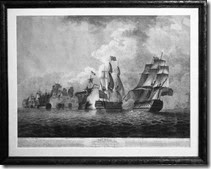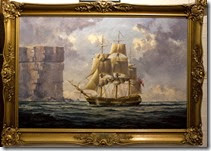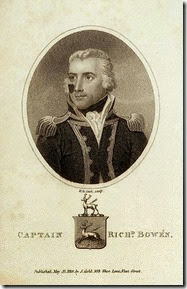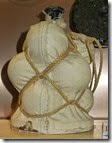On this day 25th July 1797 Lieutenant Richard Bowen the man responsible for naming Jervis Bay died during the battle of Santa Cruz de Tenerife.
21 years after Captain Cook was forced by unfavorable winds to sail past past Jervis Bay, Lieutenant Richard Bowen entered Jervis bay aboard the convict transport ship the Atlantic on August 25th 1791.
|
 Bowen gave the bay it’s English name. Bowen gave the bay it’s English name.
During August of 1791 sailing under Governor Phillip's Instructions along the eastern coast of New South Wales, seeking shelter from adverse winds, Bowen steered the Atlantic into the unmapped and unnamed bay, naming the bay after his long time friend Sir John Jervis pictured on the left.
The remarkable image below is from an engraving by Lieut.Jahleel Brenton of the Royal Navy published June 4 1798. One of three on display in the museum. It displays H.M.S.'Victory' bearing up in order to rake the 'Salvador del Munde', during a sea fight off Cape St. Vincent in 1797.
|
 In a remarkable piece of thinking Bowen suggested "the wisdom of training young navy officers in seamanship on the coast here, so that they might obtain geographical and hydrographical knowledge of this part of the world, which might eventually prove of much service to the colony." It was surely fitting then, that the Naval College which has done such good work for Australia should have been erected on the shores of the bay which the writer of those words discovered in 1791. In a remarkable piece of thinking Bowen suggested "the wisdom of training young navy officers in seamanship on the coast here, so that they might obtain geographical and hydrographical knowledge of this part of the world, which might eventually prove of much service to the colony." It was surely fitting then, that the Naval College which has done such good work for Australia should have been erected on the shores of the bay which the writer of those words discovered in 1791.
|
 Interwar years, how it came to be?. Interwar years, how it came to be?.
Between naval assignments and looking to advance himself he took the opportunity to carry out a resupply mission to the colonies in Australia, a task he completed successfully, even though it involved circumnavigating the globe., It was while he was carrying out this duty he came to enter Jervis Bay.
He only spent a short time in the bay and described the area as having good anchoring ground with a fine depth of water, He recorded that he saw two Kangaroos and many traces of habitation. A more complete mapping of the bay came later.
That’s another story for a future post.
The painting above is a depiction of the Atlantic entering Jervis Bay by celebrated marine artist Ian Hensen…this is one of many beautiful original paintings on display in the museum.
|
Richard Bowen a short but distinguished life.
 Bowen was born into a naval family in 1761 and served along side several distinguished naval figures including John Jervis and Horatio Nelson. Under Nelsons command Bowen was given the task of leading the first wave of the assault on the town of Santa Cruz de Tenerife, but the attack went badly. The defenders poured grapeshot onto the attacking British, killing and wounding many, Bowen was killed while Nelson was badly wounded. Bowen was born into a naval family in 1761 and served along side several distinguished naval figures including John Jervis and Horatio Nelson. Under Nelsons command Bowen was given the task of leading the first wave of the assault on the town of Santa Cruz de Tenerife, but the attack went badly. The defenders poured grapeshot onto the attacking British, killing and wounding many, Bowen was killed while Nelson was badly wounded.
Bowen 1761- July 25th 1797.
|
A more enterprising, able and gallant officer does not grace His Majesty’s Naval Service.
Lord Nelson wrote of Bowen’s death:
“I transmit to you a list of killed and wounded; amongst the former it is with the deepest sorrow I have to place the name of Captain Richard Bowen, of His Majesty’s Ship Terpsichore, than whom a more enterprising, able and gallant officer does not grace His Majesty’s Naval Service;”
 Grape Shot a devastating weapon. Grape Shot a devastating weapon.
In artillery, a grapeshot is a type of shot that is not one solid element, but a mass of small metal balls or slugs packed tightly into a canvas bag. It was used both in land and naval warfare. When assembled, the balls resembled a cluster of grapes, hence the name. On firing, the balls spread out from the muzzle, giving an effect similar to a giant shotgun.
|
| REF:
http://trove.nla.gov.au/ndp/del/article/28045159
http://en.wikipedia.org/wiki/Grapeshot
http://commons.wikimedia.org/wiki/File:Grape_shot.JPG |

 Bowen gave the bay it’s English name.
Bowen gave the bay it’s English name.
 Interwar years, how it came to be?.
Interwar years, how it came to be?.

No comments :
Post a Comment